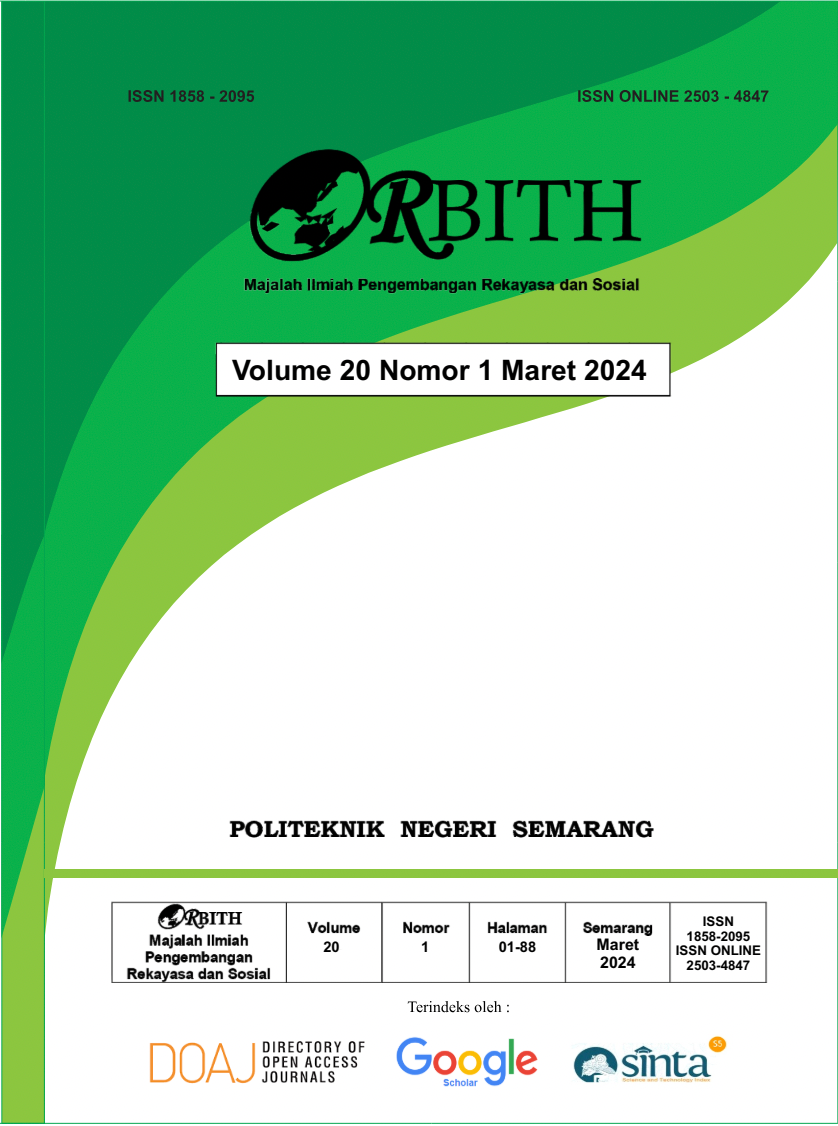MENGUNGKAP TREN DAN KEMAJUAN TERBARU DALAM MODULASI DIGITAL DAN TRANSMISI PADA SISTEM TELEKOMUNIKASI MELALUI TINJAUAN KOMPREHENSIF DAN AGENDA PENELITIAN
DOI:
https://doi.org/10.32497/orbith.v20i1.5441Keywords:
Telecommunication System, Digital Modulation, Transmission MediaAbstract
Abstrak
Kemajuan teknologi modulasi digital telah menciptakan kebutuhan akan sistem telekomunikasi yang efisien dengan kinerja tinggi yang mampu menangani pengiriman arus informasi yang begitu besar dengan tingkat kesalahan minimal. Berbagai teknologi modulasi telah menjadi pilihan populer untuk diaplikasikan dalam sistem telekomunikasi seperti penggunaan modulasi QAM, PSK, FSK dalam beberapa transmisi kabel dan nirkabel. Tinjauan literatur ini bertujuan untuk mengungkap tren dan kemajuan terbaru tentang modulasi digital pada sistem telekomunikasi dengan melakukan tinjuan yang komprehensif dari beberapa penelitian modulasi digital yang telah dilakukan serta mengidentifikasi inovasi dan strategi menghadapi tantangan sebagai bahan untuk agenda penelitian yang baru. Tinjauan ini akan bermanfaat untuk memberikan pengertian yang dalam mengenai perkembangan modulasi digital sehingga diharapkan mampu mendorong pengembangan modulasi digital pada sistem telekomunikasi yang lebih efisien.
Kata kunci: Sistem Telekomunikasi, Modulasi Digital, Media Transmisi
Abstract
The advancement of digital modulation technology has created the need for an efficient telecommunication system with high performance capable of handling the transmission of such a large flow of information with minimal error rate. Various modulation technologies have become popular choices for application in telecommunication systems such as the use of QAM, PSK, and FSK modulation in several wired and wireless transmissions. This literature review aims to uncover the latest trends and advances in digital modulation in telecommunication systems by conducting a comprehensive review of some of the digital modulation research that has been done as well as identifying innovations and strategies to face challenges as material for a new research agenda. This review will be useful to provide a deeper understanding of the development of digital modulation to encourage the development of digital modulation in more efficient telecommunication systems.
Keywords: Telecommunication System, Digital Modulation, Transmission Media
References
Karpagarajesh, G., Santhana Krishnan, R., Harold Robinson, Y., Vimal, S., Kadry, S., & Nam, Y. (2022). “Investigation of digital video broadcasting application employing the modulation formats like QAM and PSK using OWC, FSO, and LOS-FSO channels”. Alexandria Engineering Journal, 61(1), 647”“657. https://doi.org/10.1016/j.aej.2021.06.038
Kumar, S., Kumar, N., & Jain, V. (2012). “Comparison of Various Auxiliary Signals for Damping Subsynchronous Oscillations Using TCR-FC”. Energy Procedia, 14, 695”“701. https://doi.org/10.1016/j.egypro.2011.12.997
Qu, Z., & Djordjevic, I. B. (2017). “Two-stage cross-talk mitigation in an orbital-angular-momentum-based free-space optical communication system”. Optics Letters, 42(16), 3125. https://doi.org/10.1364/OL.42.003125
Usha, S. M., & Nataraj, K. R. (2016). “Bit Error Rate Analysis Using QAM Modulation for Satellite Communication Link”. Procedia Technology, 25, 456”“463. https://doi.org/10.1016/j.protcy.2016.08.132
Fuada, S., Pradana, A., Adiono, T., & Popoola, W. O. (2023). “Demonstrating a real”“time QAM”“16 visible light communications utilizing off-the-shelf hardware”. Results in Optics, 10, 100348. https://doi.org/10.1016/j.rio.2022.100348
J. Ding, Y. Wang, J. Zhang, M. He, F. Zhao, L. Zhao, W. Zhou, Y. Shi, M. Zhu, and J. Yu, "Demonstration of 352-Gbit/s Single Line Rate PS-4096QAM THz Wired Transmission over Hollow-Core Fiber," Opto-Electronics and Communications Conference, Institute of Electrical and Electronics Engineers Inc, 2021, https://doi.org/10.1364/oecc.2021.t5a.1
U. Oruthota, O. Tirkkonen, "SER/BER expression for M-QAM OFDM systems with imperfect channel estimation and I/Q imbalance," Eurasip Journal on Wireless Communications and Networking, 2012, https://doi.org/10.1186/1687-1499-2012-303
Park, H. J., Kang, S. M., Ha, I., and Han, S. K., "Hexagonal QAM-Based Four-Dimensional AMO-OFDM for Spectrally Efficient Optical Access Network Transmission," IEEE Access, 7, 176814”“176819, 2019, https://doi.org/10.1109/ACCESS.2019.2957844
Shiu, R. K., Chen, Y. W., Peng, P. C., Su, S. J., Shao, G. M., Chiu, J., Li J. W, Chang, G. K, “A Simplified Radio-Over-Fiber System for over 100-km Long-Reach n-QAM Transmission,” IEEE Photonics Journal, vol. 12, no. 3, June. 2020, https://doi.org/10.1109/JPHOT.2020.2993180
K. Maria, B. Horia, “A study on turbo coded 16-QAM bit allocation in Rice flat fading channel”, In Procedia Computer Science, vol. 56, pp. 300”“308, 2015, https://doi.org/10.1016/j.procs.2015.07.212
Demeng, Z., Jianguo, Y., Zhe, W., Jing, Z., & Lele, S. (2018). A two-stage coded modulation scheme based on the 8-QAM signal for optical transmission systems. Procedia Computer Science, 131, 964”“969. https://doi.org/10.1016/j.procs.2018.04.236
Li, F., Li, X., Zhang, J., & Yu, J. (2015). Transmission of 100-Gb/s VSB DFT-Spread DMT Signal in Short-Reach Optical Communication Systems. IEEE Photonics Journal, 7(5). https://doi.org/10.1109/JPHOT.2015.2486684
Deng, X., Yang, H., Qiuyu, W. U., Jiang, J., & Lin, C. (2022). Phase Noise Effects on the Performance of High-Order Digital Modulation Terahertz Communication System. Chinese Journal of Electronics, 31(3), 589”“594. https://doi.org/10.1049/cje.2021.00.321
Li, S.-A., Huang, H., Pan, Z., Yin, R., Wang, Y., Fang, Y., Zhang, Y., Bao, C., Ren, Y., Li, Z., & Yue, Y. (2020). Enabling Technology in High-Baud-Rate Coherent Optical Communication Systems. IEEE Access, 8, 111318”“111329. https://doi.org/10.1109/ACCESS.2020.3003331
Vallejo, L., Ortega, B., Mora, J., Nguyen, D. N., Guerra, C., Bohata, J., Spacil, J., & Zvanovec, S. (2023). Demonstration of M-QAM OFDM bidirectional 60/25 GHz transmission over 10 km Fiber, 100 m FSO and 2 m radio seamless heterogeneous fronthaul link. Optical Fiber Technology, 77. https://doi.org/10.1016/j.yofte.2022.103161
Wang, Y. H., & Li, Z. X. (2018). “Design of Wireless Node Based on AR9341”. Procedia Computer Science, 154, 416”“423. https://doi.org/10.1016/j.procs.2019.06.059
Ibrahim, A., Bedeer, E., & Yanikomeroglu, H. (2021). “A Novel Low Complexity Faster-than-Nyquist (FTN) Signaling Detector for Ultra High-Order QAM”. IEEE Open Journal of the Communications Society, 2, 2566”“2580. https://doi.org/10.1109/OJCOMS.2021.3126805
Galdino, I., Zakaria, R., le Ruyet, Di., & de Campos, M. L. R. (2022). “Prototype Filter for QAM-FBMC Systems Based on Discrete Prolate Spheroidal Sequences (DPSS)”. IEEE Access, 10, 31244”“31254. https://doi.org/10.1109/ACCESS.2022.3157304
Choi, B. H. (2023). “30.7 Tb/s Transmission over 400 km using 40 WDM channels of DP-16 QAM and Raman amplification without inline repeaters”. Optical Fiber Technology, 81. https://doi.org/10.1016/j.yofte.2023.103520
Nguyen, T. v., Pham, T. v., Dang, N. T., & Pham, A. T. (2020). “Performance of generalized QAM/FSO systems with pointing misalignment and phase error over atmospheric turbulence channels”. IEEE Access, 8, 203631”“203644. https://doi.org/10.1109/ACCESS.2020.3036643
Mahama, S., Harbi, Y. J., Burr, A. G., & Grace, D. (2020). “Design and convergence analysis of an IIC-Based BICM-ID receiver for F∗BMC-QAM systems”. IEEE Open Journal of the Communications Society, 1, 563”“577. https://doi.org/10.1109/OJCOMS.2020.2992314
Fattah, M., Abdellaoui, M., Daghouj, D., Mazer, S., el Ghazi, M., el Bekkali, M., Balboul, Y., & Bouayad, A. (2019). “Multi band OFDM alliance power line communication system”. Procedia Computer Science, 151, 1034”“1039. https://doi.org/10.1016/j.procs.2019.04.146
Mthethwa, B., & Xu, H. (2022). “Low Complexity Golden Code Analytical and Deep Learning-Based Sphere-Decoders for High-Density M-QAM”. IEEE Access, 10, 6940”“6953. https://doi.org/10.1109/ACCESS.2022.3141626
Kitchenham, B., Pearl Brereton, O., Budgen, D., Turner, M., Bailey, J., & Linkman, S. (2009). Systematic literature reviews in software engineering - A systematic literature review. In Information and Software Technology (Vol. 51, Issue 1, pp. 7”“15). https://doi.org/10.1016/j.infsof.2008.09.009
Wahono, R. S. (2015). A Systematic Literature Review of Software Defect Prediction: Research Trends, Datasets, Methods and Frameworks. Journal of Software Engineering, 1(1). http://journal.ilmukomputer.org
Winch, R. G. (1998). Telecommunication Transmission Systems (2nd ed). McGraw-Hill.
Penttinen, J. T. J. (Ed.). (2015). The Telecommunications Handbook: Engineering Guidelines for Fixed, Mobile, and Satellite Systems. Wiley.
Xiong, F. (2000). Digital Modulation Techniques. Artech House.
Downloads
Published
Issue
Section
License
Authors who publish with this journal agree to the following terms:Authors retain copyright and grant the journal right of first publication with the work simultaneously licensed under a Creative Commons Attribution License that allows others to share the work with an acknowledgement of the work's authorship and initial publication in this journal.
Authors are able to enter into separate, additional contractual arrangements for the non-exclusive distribution of the journal's published version of the work (e.g., post it to an institutional repository or publish it in a book), with an acknowledgement of its initial publication in this journal.
Authors are permitted and encouraged to post their work online (e.g., in institutional repositories or on their website) prior to and during the submission process, as it can lead to productive exchanges, as well as earlier and greater citation of published work (See The Effect of Open Access).






